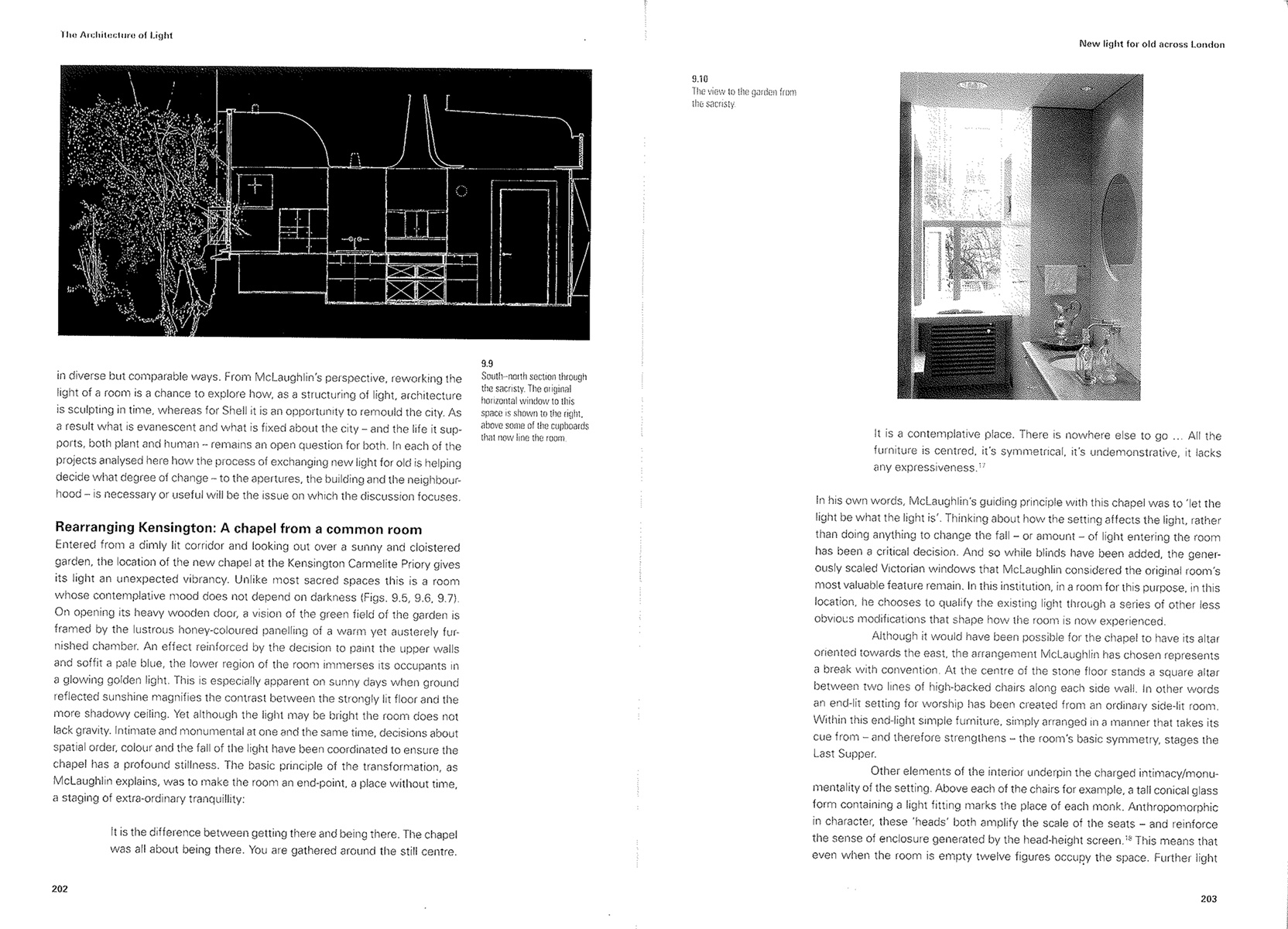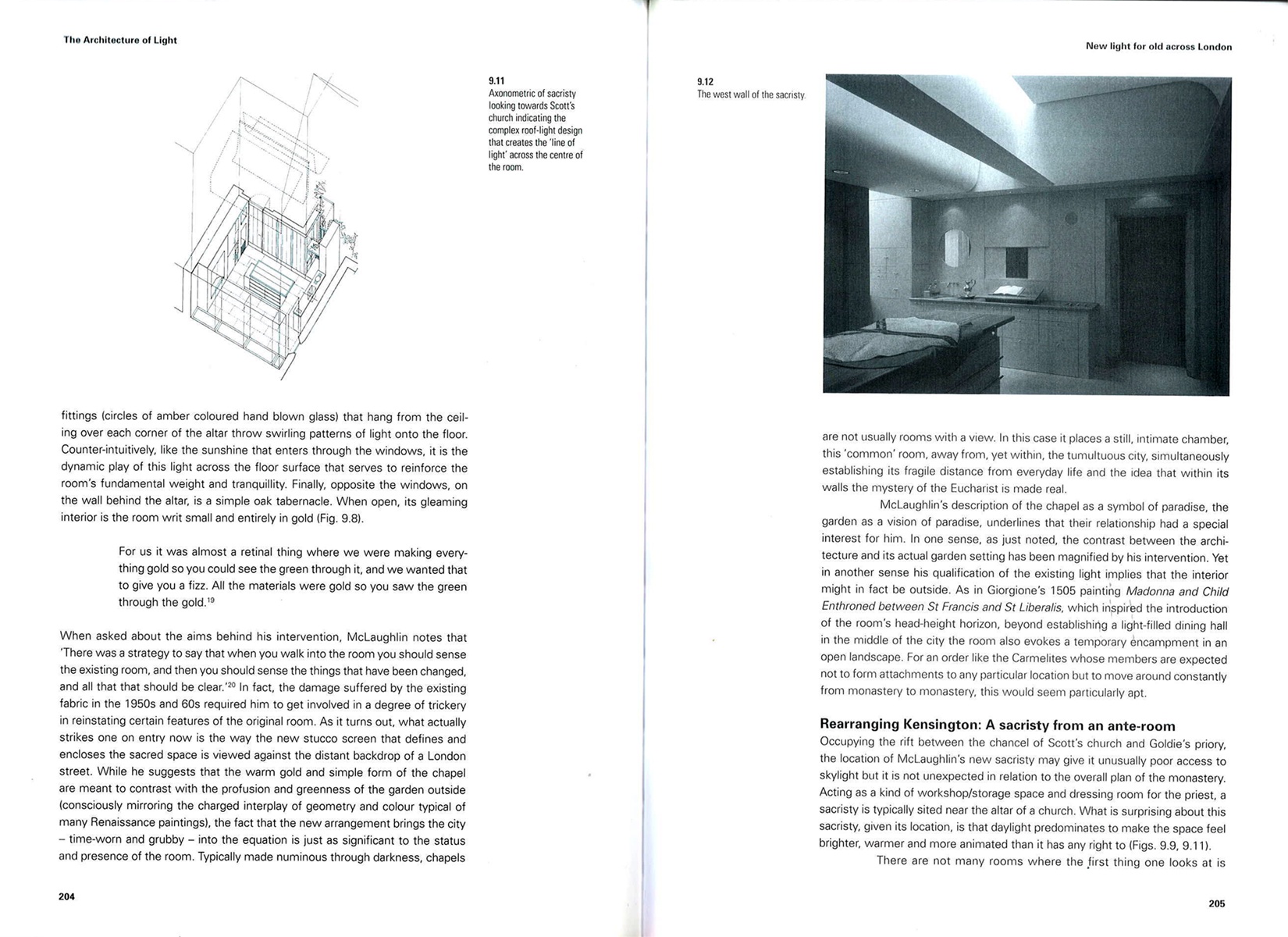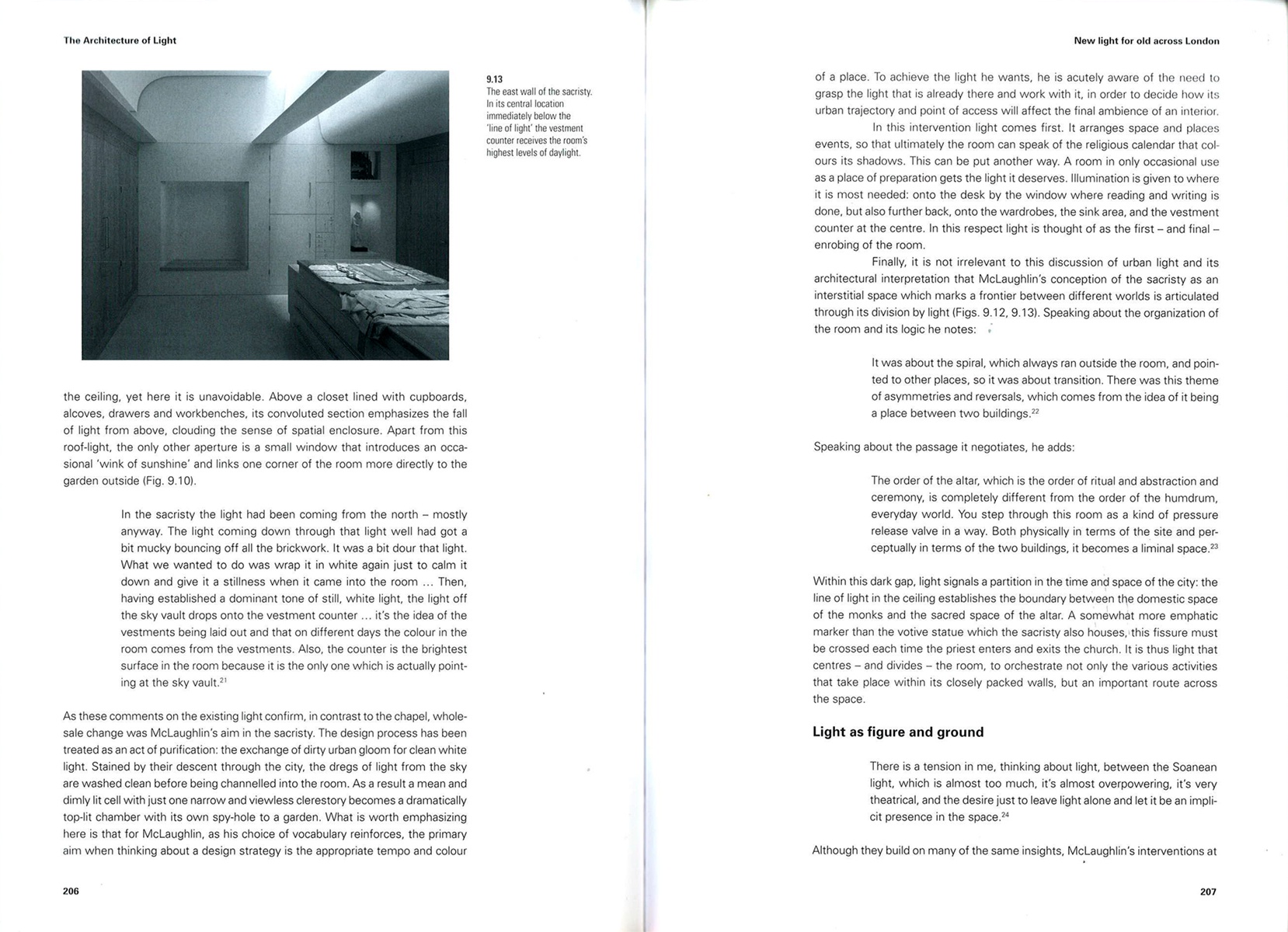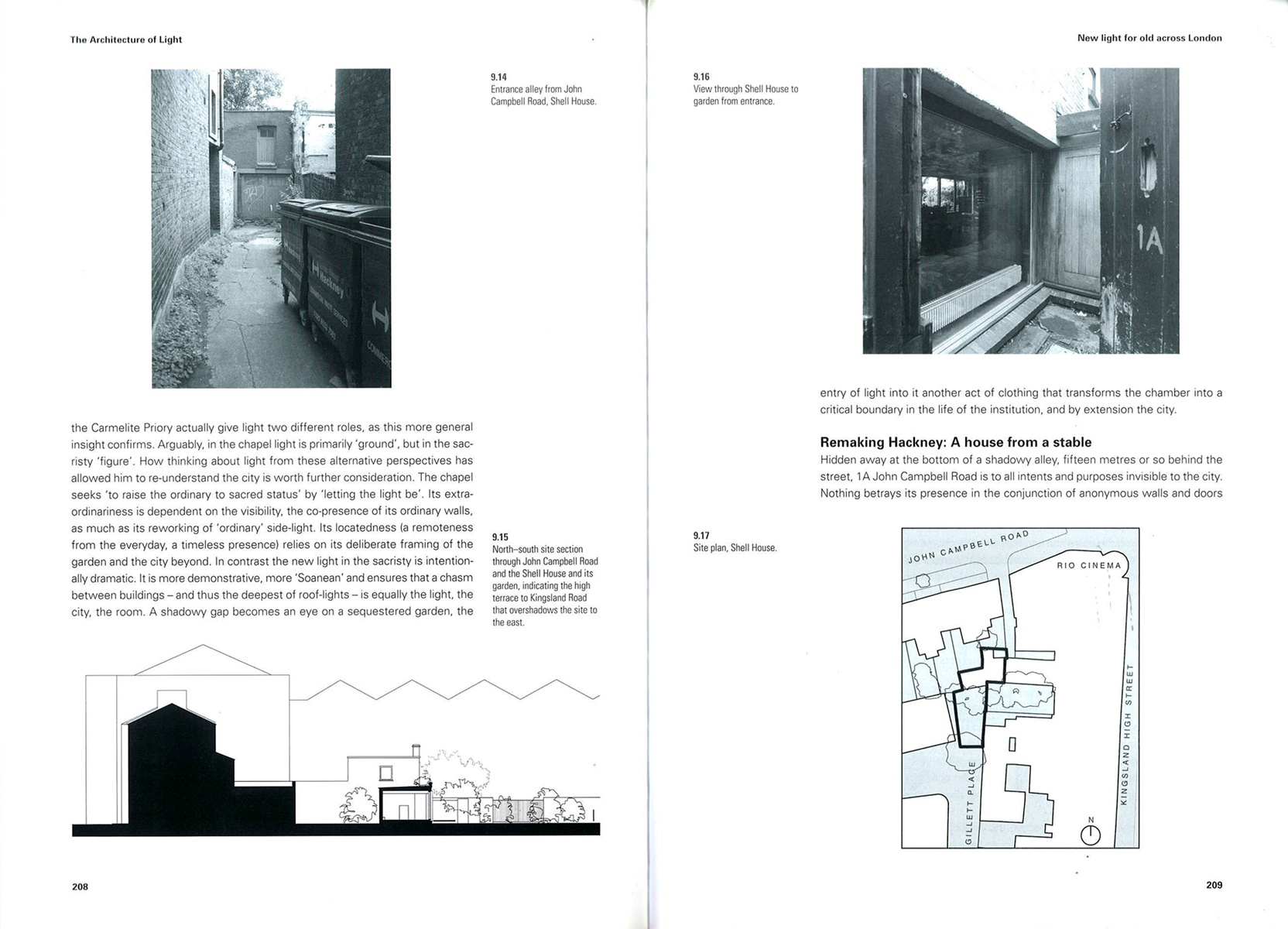The Architecture of Light
Recent Approaches to Designing with Natural Light
Published by London & New York: Routledge, 2011
Author Mary Ann Steane
Rearranging Kensington: A chapel from a common room
Entered from a dimly lit corridor and looking out over a sunny and cloistered garden, the location of the new chapel at the Kensington Carmelite Priory gives its light an unexpected vibrancy. Unlike most sacred spaces this is a room whose contemplative mood does not depend on darkness. On opening its heavy wooden door, a vision of the green field of the garden is framed by the lustrous honey-coloured panelling of a warm yet austerely furnished chamber. An effect reinforced by the decision to paint the upper walls and soffit a pale blue, the lower region of the room immerses its occupants in a glowing golden light. This is especially apparent on sunny days when ground reflected sunshine magnifies the contrast between the strongly lit floor and the more shadowy ceiling. Yet although the light may be bright the room does not lack gravity, intimate and monumental at one and the same time, decisions about spatial order, colour and the fall of the light have been coordinated to ensure the chapel has a profound stillness. The basic principle of the transformation, as McLaughlin explains, was to make the room an end-point a place without time, a staging of extraordinary tranquillity:
It is the difference between getting there and being there. The chapel was all about being there. You are gathered around the still centre. It is a contemplative place. There is nowhere else to go… All the furniture is centred, it’s symmetrical, it’s undemonstrative, it lacks any expressiveness.
In his own words, McLaughlin’s guiding principle with this chapel was to ‘let the light be what the light is.’ Thinking about how the setting affects the light, rather than doing anything to change the fall – or amount – of light entering the room has been a critical decision. And so while blinds have been added, the generously scaled Victorian windows that McLaughlin considered the original room’s most valuable feature remain. In this institution, in a room for this purpose, in this location, he chooses to qualify the existing light through a series of other less obvious modifications that shape how the room is now experienced.
Although it would have been possible for the chapel to have its altar oriented towards the east, the arrangement McLaughlin has chosen represents a break with convention. At the centre of the stone floor stands a square altar between two lines of high-backed chairs along each side wall. In other words an end-lit setting for worship has been created from an ordinary side-lit room. Within this end-light simple furniture, simply arranged in a manner that takes its cue from – and therefore strengthens – the room’s basic symmetry, stages the Last Supper.
Other elements of the interior underpin the charged intimacy/ monumentality of the setting. Above each of the chairs for example, a tall conical glass form containing a light fitting marks the place of each monk. Anthropomorphic in character, these ‘heads’ both amplify the scale of the seats – and reinforce the sense of enclosure generated by the head-height screens. This means that even when the room is empty twelve figures occupy the space. Further light fittings (circles of amber coloured hand blown glass) that hang from the ceiling over each corner of the altar throw swirling patterns of light onto the floor. Counter-intuitively, like the sunshine that enters through the windows, it is the dynamic play of this light across the floor surface that serves to reinforce the room’s fundamental weight and tranquillity. Finally, opposite the windows on the wall behind the altar, is a simple oak tabernacle. When open, its gleaming interior is the room writ small and entirely in gold.
For us it was almost a retinal thing where we were making everything gold so you could see the green through it, and we wanted that to give you a fizz. All the materials were gold so you saw the green through the gold.
When asked about the aims behind his intervention, McLaughlin notes that ‘There was a strategy to say that when you walk into the room you should sense the existing room, and then you should sense the things that have been changed, and all that that should be clear.’ In fact, the damage suffered by the existing fabric in the 1950s and 60s required him to get involved in a degree of trickery in reinstating certain features of the original room. As it turns out, what actually strikes one on entry now is the way the new stucco screen that defines and encloses the sacred space is viewed against the distant backdrop of a London street. While he suggests that the warm gold and simple form of the chapel are meant to contrast with the profusion and greenness of the garden outside (consciously mirroring the charged interplay of geometry and colour typical of many Renaissance paintings), the fact that the new arrangement brings the city – time-worn and grubby – into the equation is just as significant to the status and presence of the room. Typically made numinous through darkness, chapels are not usually rooms with a view. In this case it places a still, intimate chamber, this ‘common’ room, away from, yet within, the tumultuous city, simultaneously establishing its fragile distance from everyday life and the idea that within its walls the mystery of the Eucharist is made real.
McLaughlin’s description of the chapel as a symbol of paradise, the garden as a vision of paradise, underlines that their relationship had a special interest for him. In one sense, as just noted, the contrast between the architecture and its actual garden setting has been magnified by his intervention. Yet in another sense his qualification of the existing light implies that the interior might in fact be outside. As in Giorgione’s 1505 painting Madonna and Child Enthroned between St Francis and St Liberalis, which inspired the introduction of the room’s head-height horizon, beyond establishing a light-filled dining hall in the middle of the city the room also evokes a temporary encampment in an open landscape. For an order like the Carmelites whose members are expected not to form attachments to any particular location but to move around constantly from monastery to monastery, this would seem particularly apt.
Rearranging Kensington: A sacristy from an ante-room
Occupying the rift between the chancel of Scott’s church and Goldie’s priory, the location of McLaughlin’s new sacristy may give it unusually poor access to skylight but it is not unexpected in relation to the overall plan of the monastery. Acting as a kind of workshop/storage space and dressing room for the priest, a sacristy is typically sited near the altar of a church. What is surprising about this sacristy, given its location, is that daylight predominates to make the space feel brighter, warmer and more animated than it has any right to.
There are not many rooms where the first thing one looks at is the ceiling, yet here it is unavoidable. Above a closet lined with cupboards, alcoves, drawers and workbenches, its convoluted section emphasises the fall of light from above, clouding the sense of spatial enclosure. Apart from this roof-light, the only other aperture is a small window that introduces an occasional ‘wink of sunshine’ and links one corner of the room more directly to the garden outside.
In the sacristy the light had been coming from the north – mostly anyway. The light coming down through that light well had got a bit mucky bouncing off all the brickwork. It was a bit dour that light. What we wanted to do was wrap it in white again just to calm it down and give it a stillness when it came into the room … Then, having established a dominant tone of still, white light, the light off the sky vault drops onto the vestment counter … it’s the idea of the vestments being laid out and that on different days the colour in the room comes from the vestments. Also, the counter is the brightest surface in the room because it is the only one which is actually pointing at the sky vault.
As these comments on the existing light confirm, in contrast to the chapel, wholesale change was McLaughlin’s aim in the sacristy. The design process has been treated as an act of purification: the exchange of dirty urban gloom for clean white light. Stained by their descent through the city, the dregs of light from the sky are washed clean before being channelled into the room. As a result a mean and dimly lit cell with just one narrow and viewless clerestory becomes a dramatically top-lit chamber with its own spy-hole to a garden. What is worth emphasising here is that for McLaughlin, as his choice of vocabulary reinforces, the primary aim when thinking about a design strategy is the appropriate tempo and colour of a place. To achieve the light he wants, he is acutely aware of the need to grasp the light that is already there and work with it, in order to decide how its urban trajectory and point of access will affect the final ambience of an interior.
In this intervention light comes first. It arranges space and places events, so that ultimately the room can speak of the religious calendar that colours its shadows. This can be put another way. A room in only occasional use as a place of preparation gets the light it deserves. Illumination is given to where it is most needed: onto the desk by the window where reading and writing is done, but also further back, onto the wardrobes, the sink area, and the vestment counter at the centre. In this respect light is thought of as the first – and final – enrobing of the room.
Finally, it is not irrelevant to this discussion of urban light and its architectural interpretation that McLaughlin’s conception of the sacristy as an interstitial space which marks a frontier between different worlds is articulated through its division by light. Speaking about the organisation of the room and its logic he notes:
It was about the spiral, which always ran outside the room, and pointed to other places. so it was about transition. There was this theme of asymmetries and reversals, which comes from the idea of it being a place between two buildings, it becomes a liminal space.
Speaking about the passage it negotiates, he adds:
The order of the altar, which is the order of ritual and abstraction and ceremony, is completely different from the order of the humdrum, everyday world. You step through this room as a kind of pressure release valve in a way. Both physically in terms of the site and perceptually in terms of the two buildings, it becomes a liminal space.
Within this dark gap, light signals a partition in the time and space of the city: the line of light in the ceiling establishes the boundary between the domestic space of the monks and the sacred space of the altar. A somewhat more emphatic marker than the votive statue which the sacristy also houses, this fissure must be crossed each time the priest enters and exits the church. It is thus light that centres – and divides – the room, to orchestrate not only the various activities that take place within its closely packed walls, but an important route across the space.
Light as figure and ground
There is a tension in me, thinking about light, between the Soanean light, which is almost too much, it’s almost overpowering, it’s very theatrical, and the desire just to leave light alone and let it be an implicit presence in the space.
Although they build on many of the same insights, McLaughlin’s interventions at the Carmelite Priory actually give light two different roles, as this more general insight confirms. Arguably, in the chapel light is primarily ‘ground’, but in the sacristy ‘figure’. How thinking about light from these alternative perspectives has allowed him to re-understand the city is worth further consideration. The chapel seeks ‘to raise the ordinary to sacred status’ by ‘letting the light be’. Its extra ordinariness is dependent on the visibility, the co-presence of its ordinary walls, as much as its reworking of ‘ordinary’ side-light. Its locatedness (a remoteness from the everyday, a timeless presence) relies on its deliberate framing of the garden and the city beyond. In contrast the new light in the sacristy is intentionally dramatic. It is more demonstrative, more ‘Soanean’ and ensures that a chasm between buildings – and thus the deepest of roof-lights – is equally the light, the city, the room. A shadowy gap becomes an eye on a sequestered garden, the entry of light into it another act of clothing that transforms the chamber into a critical boundary in the life of the institution and by extension the city.
Download Extract in Pdf



